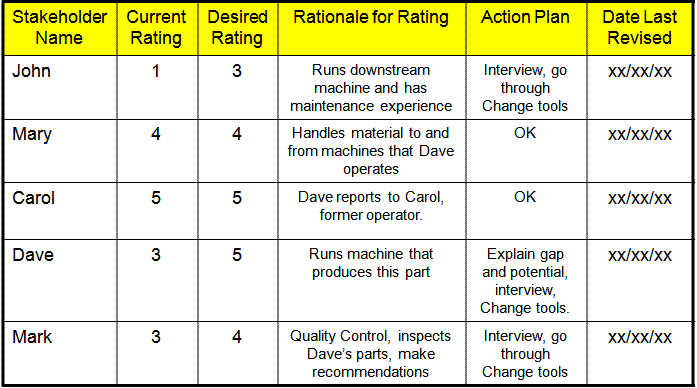Stakeholder Analysis
Description:
The Stakeholder Analysis is a chart which gauges the positioning of stakeholders relative to change and commitment to the goals of the team.
Objective:
Most successful Six Sigma projects involve a fundamental shift in process performance which involved physical and cultural (emotional) change. This often stirs emotions, touches feelings, and encounters resistance.
The higher the impact of the projected change the more important this tool becomes. The output of the Stakeholder Analysis is a representation of where the impacted people both inside and outside the system stand relative to change.
The Six Sigma project manager uses this information to prepare and overcome any resistance that could prohibit or delay improvements.
A sample template is shown below:

It is important that the team starts its journey with team members and stakeholders that minimize resistance to change.
This tool is commonly used in DFSS or DMAIC projects throughout the duration especially if it is a longer term project. It's objective is to detect and "out of control" position by a key team member and get it corrected by continually monitoring this behavioral pattern.
Those that are not at the level of commitment or willingness to accept change need to be converted.
This tool is also used as a Project Accelerator. There are a number of techniques to accelerate a project and various tools work depending on the situation. This tool is used to keep track of resources on the team to get the best results in the shortest amount of time.
STEPS
1. List all stakeholder names on the team. Other stakeholders are the community, customers, stockholders, but are not included in this exercise.
2. Provide a number of 1-5 to indicate their CURRENT and DESIRED willingness to embrace change and make cultural commitment to advocate the change.
Note that not all members may need to be a 4 or 5, but since a major breakthrough, technical, or cultural change requires a team effort it is important to have the core team neutral or better before starting or proceeding to the next step.
3. Document the roles and the relationships members that impact one another, boss, co-worker, material handler, and operators.
4. Develop a plan to get individuals to desired rating quickly. If the plan is not working the person may need to be replaced before proceeding.
The Stakeholder Analysis tool (similar to the Pareto Diagram) may be used at any time during any phase to gauge the member's positioning. However, overuse might indicate a trust issue within the team.
Site Membership
Click for a Password
to access entire site
Six Sigma
Templates & Calculators
Six Sigma Modules
The following are available
Click Here
Green Belt Program (1,000+ Slides)
Basic Statistics
Cost of Quality
SPC
Process Mapping
Capability Studies
MSA
Cause & Effect Matrix
FMEA
Multivariate Analysis
Central Limit Theorem
Confidence Intervals
Hypothesis Testing
T Tests
1-Way ANOVA
Chi-Square
Correlation and Regression
Control Plan
Kaizen
MTBF and MTTR
Project Pitfalls
Error Proofing
Effective Meetings
OEE
Takt Time
Line Balancing
Practice Exam
... and more